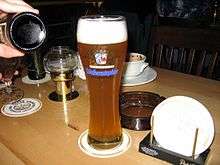Weihenstephan Abbey

Weihenstephan Abbey (Kloster Weihenstephan) was a Benedictine monastery in Weihenstephan, now part of the district of Freising, in Bavaria, Germany. Brauerei Weihenstephan, located at the monastery site since at least 1040, is said to be the world's oldest continuously operating brewery.[1]
Monastery
Saint Korbinian, whose arrival in Freising is dated at around 720, founded a church dedicated to Saint Stephen here. A dormitory for monks that originally adjoined the building disappears from records by the end of the eighth century. The monastery itself, dedicated at first to Saint Vitus, then later to Saints Stephen and Michael, was founded by Bishop Hitto von Freising between 811 and 835. From then until 1020 or 1021 it was a monastery of Augustinian canons before becoming a Benedictine abbey.
The abbey was dissolved in 1803 during the secularisation of Bavaria and its property sold off. In 1810 the abbey church, which had been made into a parish church, was demolished.
School
In 1803 the Forestry School of Munich was moved into the empty buildings; at the same time a model farm was established. A large part of the previous abbey economy, with buildings and stables as well as forests and fields, was transferred to the forestry school or the model farm. From 1804 agricultural science was taught here by Max Schönleutner.
As early as 1807 both schools were wound up, as many teachers and students had taken part in Napoleon's invasion of Russia, from which few had returned. In 1852 the agricultural school was re-established in Weihenstephan and in 1895 became an agricultural college, which formed the nucleus of the Technical University of Munich life sciences campus in Freising.
Brewery

The world's oldest continuously operating brewery
The Weihenstephan Brewery can trace its roots at the abbey to 768, as a document from that year refers to a hop garden in the area paying a tithe to the monastery. A brewery was licensed by the City of Freising in 1040, and that is the founding date claimed by the modern brewery. The brewery thus has a credible claim to being the oldest working brewery in the world.[1] (Weltenburg Abbey, also in Bavaria, has had a brewery in operation since 1050, and also claims to be the oldest brewery in the world.) When the monastery and brewery were secularised in 1803, they became possessions of the State of Bavaria.
Late history
Since 1923, the brewery has been known as the Bavarian State Brewery Weihenstephan (in German Bayerische Staatsbrauerei Weihenstephan), and is operated in conjunction with the Technical University of Munich as both a state-of-the-art production facility and a centre for learning.[2]
The brewery produces a range of pale lagers and wheat beers including Weihenstephaner Weissbier, a 5.4% ABV weissbier which is available in filtered (Kristall)[3] and unfiltered (Hefe)[4] versions.[5] The strongest beers the brewery produces are Infinium (10.5% ABV), Vitus (a 7.7% ABV wheat beer) and Korbinian (a 7.4% ABV strong lager or bock).[2][6]
References
- 1 2 "Indulge in the Bavarian Weiss", BeerHunter.com, Michael Jackson, September 2, 1998.
- 1 2 "Weihenstephan Brewery website".
- ↑ "Weihenstephaner Kristall Weissbier from Bayerische Staatsbrauerei Weihenstephan - Ratebeer". www.ratebeer.com. Retrieved 2009-05-28.
- ↑ "Weihenstephaner Hefeweissbier - Brauerei Weihenstephan - BeerAdvocate". beeradvocate.com. Retrieved 2009-05-28.
- ↑ Rubin, Josh (June 4, 2008). "Bavaria still bottling monks' wheat brew". Toronto Star. Retrieved May 28, 2009.
- ↑ RateBeer
External links
Coordinates: 48°23′43″N 11°43′42″E / 48.3951388889°N 11.7283333333°E